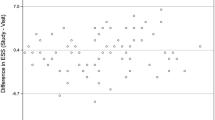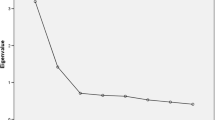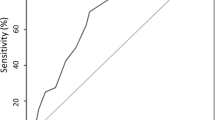Abstract
Purpose
We aimed to verify whether it is clinically useful to repeat the Epworth Sleepiness Scale (ESS) in individuals with suspected sleep-disordered breathing (SDB).
Methods
In this cross-sectional, prospective study, results of the repeated administration of the ESS were analyzed. In 929 consecutive patients, ESS was obtained as usual in the laboratory routine, immediately before the sleep study (ESS1) and was repeated in the morning, after the polysomnography (ESS2). ROC curve, classical psychometry, and item response theory (IRT) Rasch analysis were used to assess measurement properties of ESS.
Results
The ESS1 score was (mean ± SD), 11 ± 5.1, and the ESS2, 13 ± 4.7 (p < 0.001). Change in ESS score is explained in multivariate analysis by age, but not by gender, educational level, change in Stanford Sleepiness Scale, symptoms of sleep disorder, or polysomnography results. Accuracy of an ESS score >10 to predict apnea–hypopnea index ≥5 increased from 56% (ESS1) to 72% (ESS2). IRT psychometric properties (unidimensionality, invariance, local independence) were maintained in ESS2.
Conclusions
Repeating the administration of the Epworth Sleepiness Scale in a clinical setting increases its score and diagnostic accuracy and correlation with SDB variables, without changing the psychometric properties of the scale. This experiment indicates the clinical usefulness of repeating the ESS. The scale can be repeated at a negligible cost, before dismissing individual patients on the basis of a low ESS score, discontinuing a potentially lifesaving diagnostic and therapeutic process.



Similar content being viewed by others
Abbreviations
- AHI:
-
Apnea–hypopnea index
- chi2 :
-
Chi-square
- DIF:
-
Differential item functioning
- ESS:
-
Epworth Sleepiness Scale
- ESS1:
-
ESS administered at evening, before polysomnography
- ESS2:
-
ESS administered in the morning, after polysomnography
- IRT:
-
Item response theory
- OSAHS:
-
Obstructive sleep apnea–hypopnea syndrome
- PSG:
-
Polysomnography
- SaO2 :
-
Arterial oxygen saturation
- SDB:
-
Sleep-disordered breathing
References
Flemons WW (2002) Obstructive sleep apnea. N Engl J Med 347:498–504
American Academy of Sleep Medicine (2005) The international classification of sleep disorders: diagnostic and coding manual, 2nd edn. American Academy of Sleep Disorders, Westchester
Epstein LJ, Kristo D, Strollo PJ Jr, Friedman N, Malhotra A, Patil SP, Ramar K, Rogers R, Schwab RJ, Weaver EM, Weinstein MD (2009) Clinical guideline for the evaluation, management and long-term care of obstructive sleep apnea in adults. J Clin Sleep Med 5:263–276
Johns M (1999) Rethinking the assessment of sleepiness. Sleep Med Rev 2:3–15
Martinez D, Lumertz MS, Lenz Mdo C (2009) Dimensions of sleepiness and their correlations with sleep-disordered breathing in mild sleep apnea. J Bras Pneumol 35:507–514
Tachibana N, Taniguchi M (2007) Why do we continue to use Epworth sleepiness scale? Sleep Med 8:541–542
George PT (2001) Sleepiness, troika of consciousness cycle, and the epworth sleepiness scale. Sleep Breath 5:181–191
Johns MW (1991) A new method for measuring daytime sleepiness: the Epworth sleepiness scale. Sleep 14:540–545
Leineweber C, Kecklund G, Janszky I, Akerstedt T, Orth-Gomer K (2004) Snoring and progression of coronary artery disease: the Stockholm Female Coronary Angiography Study. Sleep 27:1344–1349
Tsara V, Serasli E, Amfilochiou A, Constantinidis T, Christaki P (2004) Greek version of the epworth sleepiness scale. Sleep Breath 8:91–95
Izci B, Ardic S, Firat H, Sahin A, Altinors M, Karacan I (2008) Reliability and validity studies of the turkish version of the epworth sleepiness scale. Sleep Breath 2:161–168
Thomas GN, Jiang CQ, Lao XQ, McGhee SM, Zhang WS, Schooling CM, Adab P, Lam TH, Cheng KK (2006) Snoring and vascular risk factors and disease in a low-risk Chinese population: the Guangzhou Biobank Cohort Study. Sleep 29:896–900
Beiske KK, Kjelsberg FN, Ruud EA, Stavem K (2009) Reliability and validity of a Norwegian version of the epworth sleepiness scale. Sleep Breath 13:65–72
Chan EYT, Ng DK, Chan C, Kwok K, Chow P, Cheung JM, Leung SY (2009) Modified Epworth Sleepiness Scale in chinese children with obstructive sleep apnea: a retrospective study. Sleep Breath 13:59–63
Bausmer U, Gouveris H, Selivanova O, Goepel B, Mann W (2010) Correlation of the Epworth Sleepiness Scale with respiratory sleep parameters in patients with sleep-related breathing disorders and upper airway pathology. Eur Arch Otorhinolaryngol. doi:10.1007/s00405-010-1250-y
Jiménez-Correa U, Haro R, González-Robles RO, Velázquez-Moctezuma J (2010) How is the Epworth Sleepiness Scale related with subjective sleep quality and polysomnographic features in patients with sleep-disordered breathing? Sleep Breath. doi:10.1007/s11325-010-0372-1
Cho YW, Lee JH, Son HK, Lee SH, Shin C, Johns MW (2010) The reliability and validity of the korean version of the epworth sleepiness scale. Sleep Breath. doi:10.1007/s11325-010-0343-6
Kumar S, Bhatia M, Behari M (2003) Excessive daytime sleepiness in Parkinson’s disease as assessed by Epworth Sleepiness Scale (ESS). Sleep Med 4:339–342
DeZee KJ, Jackson JL, Hatzigeorgiou C, Kristo D (2006) The epworth sleepiness scale: Relationship to sleep and mental disorders in a sleep clinic. Sleep Med 7:327–332
Sanford SD, Lichstein KL, Durrence HH, Riedel BW, Taylor DJ, Bush AJ (2006) The influence of age, gender, ethnicity, and insomnia on epworth sleepiness scores: a normative US population. Sleep Med 7:319–326
Miletin MS, Hanly PJ (2003) Measurement properties of the Epworth sleepiness scale. Sleep Med 4:195–199
Johns MW (1994) Sleepiness in different situations measured by the Epworth Sleepiness Scale. Sleep 17:703–710
Chervin RD (2003) Epworth sleepiness scale? Sleep Med 4:175–176
Smith SS, Oei TP, Douglas JA, Brown I, Jorgensen G, Andrews J (2008) Confirmatory factor analysis of the Epworth Sleepiness Scale (ESS) in patients with obstructive sleep apnoea. Sleep Med 9:739–744
Wirtz M, Böcker M (2007) Properties and benefits of applying the Rasch model in clinical diagnostics. Rehabilitation 46:238–245
Embretson SE, Reise SP (2000) Item response theory for psychologists. Erlbaum, Mahwah, NJ
Guyatt GH, Kirschner B, Jaeschke R (1992) Measuring health status: what are the necessary measurement properties? J Clin Epidemiol 45:1347–1351
Wright JG, Feinstein AR (1992) A comparative contrast of clinimetric and psychometric methods for constructing indexes and rating scales. J Clin Epidemiol 45:1201–1218
Takegami M, Suzukamo Y, Wakita T, Noguchi H, Chin K, Kadotani H, Inoue Y, Oka Y, Nakamura T, Green J, Johns MW, Fukuhara S (2009) Development of a Japanese version of the Epworth Sleepiness Scale (JESS) based on item response theory. Sleep Med 10:556–565
Maassen GH (2004) The standard error in the Jacobson and Truax Reliable Change Index: the classical approach to the assessment of reliable change. J Int Neuropsych Soc 10:888–893
Smith S, Sullivan KA (2007) A reliable change index (RCI) for the Epworth Sleepiness Scale (ESS). Sleep Med 9:102
Lenz MC, Martinez D (2007) Awakenings change results of nighttime ambulatory blood pressure monitoring. Blood Press Monit 12:9–15
Kumru H, Santamaria J, Belcher R (2004) Variability in the Epworth Sleepiness Scale score between the patient and the partner. Sleep Med 5:369–371
Nguyen AT, Baltzan MA, Small D, Wolkove N, Guillon S, Palayew M (2006) Clinical reproducibility of the Epworth Sleepiness Scale. J Clin Sleep Med 2:170–174
Knutson KL, Rathouz PJ, Yan LL, Liu K, Lauderdale DS (2006) Stability of the Pittsburgh Sleep Quality Index and the Epworth Sleepiness Questionnaires over 1 year in early middle-aged adults: the CARDIA study. Sleep 29:1503–1506
Pien GW, Fife D, Pack AI, Nkwuo JE, Schwab RJ (2005) Changes in symptoms of sleep-disordered breathing during pregnancy. Sleep 28:1299–1305
Chin K, Fukuhara S, Takahashi K, Sumi K, Nakamura T, Matsumoto H, Niimi A, Hattori N, Mishima M, Nakamura T (2004) Response shift in perception of sleepiness in obstructive sleep apnea–hypopnea syndrome before and after treatment with nasal CPAP. Sleep 27:490–493
Zimmermann C, Kohler D, Schonhofer B (2000) Value of retrospective assessment of the Epworth Sleepiness Scale after long-term CPAP therapy in obstructive sleep apnea disorder. Pneumologie 54:572–574
Philip P, Taillard J, Quera-Salva MA, Bioulac B, Akerstedt T (1999) Simple reaction time, duration of driving and sleep deprivation in young versus old automobile drivers. J Sleep Res 8:9–14
Holty JE, Parimi N, Ballesteros M, Blackwell T, Cirangle PT, Jossart GH, Kimbrough ND, Rose JM, Stone KL, Bravata DM (2010) Does surgically induced weight loss improve daytime sleepiness? Obes Surg. doi:10.1007/s11695-010-0213-0
Walter TJ, Foldvary N, Mascha E, Dinner D, Golish J (2002) Comparison of Epworth Sleepiness Scale scores by patients with obstructive sleep apnea and their bed partners. Sleep Med 3:29–32
Acknowledgement
The authors declare that they have no conflict of interest.
Author information
Authors and Affiliations
Corresponding author
Additional information
The project was supported partly by a research grant from institutional agency FIPE-HCPA. Magali Lumertz, a researcher, was supported by a government student grant from governmental agency FAPERGS. Tiago Breitenbach was supported by a government student grant from governmental agency BIC-CNPq-UFRGS, and Cristiane Maria Cassol was supported by government student grant from governmental agency CAPES.
Rights and permissions
About this article
Cite this article
Martinez, D., Cataldo Breitenbach, T., Santos Lumertz, M. et al. Repeating administration of Epworth Sleepiness Scale is clinically useful. Sleep Breath 15, 763–773 (2011). https://doi.org/10.1007/s11325-010-0434-4
Received:
Revised:
Accepted:
Published:
Issue Date:
DOI: https://doi.org/10.1007/s11325-010-0434-4




